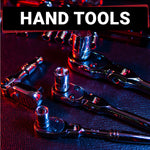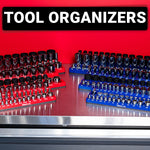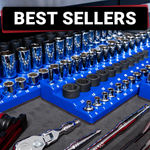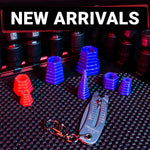A wrench grips, loosens, tightens, and adjusts fasteners. Most jobs require these specialized tools, and every mechanic or handyman needs several types in their toolbox.
Before exploring different wrenches, let's outline the typical components you’ll find on a wrench:
- Head: The end part that fits onto fasteners. Its shape adjusts to grip fasteners.
- Jaws: The gripping surfaces inside the head that touch the fastener. Their shape is different for each wrench type.
- Beam: The long metal shaft that provides leverage for turning fasteners.
- Handle: The gripping area of the wrench. It’s often coated with rubber or plastic for comfort.
- Size markings: Numbers stamped or etched into the metal. They show the wrench size in SAE or metric.
- Finish: The chrome plating on the wrench. It prevents rust and protects the metal surface.
Vocabulary lesson complete. Let's look at 25 common wrench types you’ll find at the store. Pick the right wrench for your next job to work faster and avoid damaging fasteners.
Adjustable Wrench
An adjustable wrench (also known as a crescent wrench after the popular manufacturer) has a movable jaw that opens and closes via a worm gear. The adjustable jaws let you work with different fastener sizes using just one wrench. The gear takes up space, so don’t use these in tight spaces. Adjustable wrenches are best for general use and as a backup in case you can’t find a fixed wrench.
Open-End Wrench
An open-end wrench has a U-shaped opening on each end, with differently sized openings. The flat jaws grip two sides of a fastener, so you can work in areas where a closed-end tool won't fit. Each end fits one specific size nut or bolt, so mechanics need full sets in SAE and metric measurements.
Combination Wrench
A combination wrench has an open end and a box end of the same size on opposite sides. The open end slides onto fasteners from the side, while the box end surrounds them with internal points that grip all sides.
Most mechanics start with the box end for breaking loose stubborn fasteners, then switch to the open end for faster turns. With the 15-degree offset, they can access awkward spaces more easily.
Stubby Wrench
A stubby wrench has a shorter handle for working in tight spaces. The compact design fits into tight engine compartments and other areas where standard-length wrenches won't fit. The stubby design comes in combination, ratcheting, box, and open-ended wrench styles.
These short wrenches provide the same functions as their full-size counterparts but sacrifice leverage for accessibility. The reduced length lets mechanics turn fasteners in spots with minimal clearance, such as between engine components or inside machinery housings.
Box-End Wrench
A box-ended wrench (or box wrench) has a closed loop on both ends that fully surrounds nuts and bolts. Each end fits one size fastener and contains 6 or 12 points that grip all sides. The closed design prevents slipping and won't round off fastener corners. Each end is different so each wrench works with two sizes of nuts.
Offset Wrench
An offset wrench has heads bent at an angle from the handle. The angled design keeps your hand clear of obstacles while keeping the wrench head aligned with fasteners. Both ends have either box or open-end fittings.
The offset places the handle higher than standard wrenches to clear nearby parts. This gives knuckle clearance in tight spots and improves access to fasteners blocked by other components.
Check out our slim open-end offset wrenches.
Plier Wrench
A plier wrench has smooth, parallel jaws that adjust like pliers but grip like a wrench. The push-button adjustment sets the jaw width, and squeezing the handles creates strong parallel pressure on fasteners.
The smooth jaws won't damage chrome or polished surfaces on plumbing fixtures and finished nuts. A lever action multiplies hand force, so you need less strength to grip and turn stubborn fasteners.
Allen Wrench
An Allen wrench (or hex key) has a hexagonal L-shaped design that fits into six-sided socket-head screws and bolts. One end has a longer arm for reach and torque, while the shorter end works in tight spots.
SAE and metric Allen wrenches come in sets because each wrench fits only one size. The simple one-piece steel construction fits deeply into fastener heads for a solid grip without slipping out.
Torque Wrench
A torque wrench applies specific amounts of force when tightening fasteners. An adjustable head sets precise torque values in foot pounds or Newton meters. A clicking sound or physical snap signals when you've reached the set torque limit.
Most torque wrenches have 1/4, 3/8, or 1/2-inch drive sizes for different applications. A calibrated scale shows the exact force applied, which mechanics use for critical fasteners on engines, suspension parts, and wheels.
Check out our click torque wrenches!
Ratchet Wrench
A ratcheting wrench has a box end with internal gears that let you turn fasteners without removing the wrench. The ratcheting mechanism switches direction for tightening or loosening. A small lever or switch on the head controls the direction.
Our ratcheting wrench heads contain 120 teeth for precise movements in tighter spaces, requiring only a 3-degree swing arc.
Socket Wrench
A socket wrench, also called a ratchet, has a rotating square drive that accepts interchangeable sockets. The internal gears let you turn fasteners without removing the wrench. A direction lever switches between tightening and loosening motions.
Socket wrenches come in 1/4, 3/8, and 1/2-inch drive sizes for different torque requirements, and full socket sets can fit each drive. Each socket size grips six or twelve points around nuts and bolts.
Pipe Wrench
A pipe wrench grips and turns round threaded pipes and pipe fittings with its serrated, offset jaws. The upper jaw adjusts by turning a ring, while the lower jaw remains fixed. The teeth bite harder into the pipe surface as more turning force gets applied.
The long handle gives leverage for stubborn pipes, and the jaws self-tighten during use. The serrated teeth will mark the pipe surface, so this wrench works mainly on rough plumbing jobs rather than finished fixtures.
Impact Wrench
An impact wrench uses compressed air or electricity to deliver high torque with rapid hammer blows. The internal mechanism combines rotation with percussive force to break loose stubborn fasteners and a trigger controls the power and speed.
Air-powered models connect to compressors, while cordless versions run on rechargeable batteries. The square drive head accepts standard impact sockets in 1/4, 3/8, and 1/2-inch sizes. The hammering action requires special black impact sockets rather than standard chrome ones.
Oil Filter Wrench
An oil filter wrench removes and installs engine oil filters. It comes in two common types: a band strap that wraps around the filter, or a cup style that fits over the filter's end. The strap style adjusts to fit different filter sizes, while cup wrenches must match your filter diameter.
Basin Wrench
A basin wrench has a long shaft with spring-loaded jaws on a pivoting head. The T-shaped handle turns an extra-long stem that reaches deep under sinks. The head rotates 180 degrees to grip nuts from any angle.
The self-adjusting jaws clamp onto faucet nuts and plumbing fittings in tight spaces. A sliding T-bar at the top provides leverage when turning the long shaft, while a narrow handle lets you maneuver between pipes and walls.
Fan Clutch Wrench
A fan clutch wrench has a unique head that removes and installs engine cooling fan clutches. The specialized jaw pattern fits the notches or pins on fan clutch hubs. The offset handle clears fan blades and other engine components. This specialized fan clutch wrench simplifies fan clutch maintenance and repairs. There are also flat clutch wrenches for low-clearance applications.
Flare Nut Wrench
A flare nut wrench has a six-point opening that surrounds the sides of a flare nut. The deep slot wraps around brake and fuel lines without sliding over the end. Six internal points contact more surface area than standard open-ended wrenches to prevent rounding off flare nuts on brake and fuel line fittings. A 15-degree offset keeps fingers away from sharp edges.
Pedal Wrench
A pedal wrench has a thin, open end with a long handle for bicycle pedal removal and installation. The slim jaws fit the narrow space between the pedals and cranks. The extended handle provides leverage to break loose tight pedal threads.
The wrench head sits at a 15-degree angle and measures 15 mm, the standard size for pedal axles. The length of the handle multiplies the force for loosening pedals that become tight over time, without putting stress on the bicycle's crankset. It is used by bike mechanics for quick bicycle repairs.
Dog Bone Wrench
A dog bone wrench has multiple socket sizes built into a single flat piece of metal. Each end contains a range of sizes in a bone-shaped pattern. The compact, multi-size design fits common fastener sizes without needing separate sockets.
The openings are sized for the most common fasteners in SAE or metric measurements. Unlike socket sets, all sizes remain attached to prevent loss, and the flat shape requires minimal space in a tool kit or emergency bag.
Crowfoot Wrench
A crowfoot wrench has an open-end or box-end head at a right angle to its connector end. The connector attaches to a ratchet or breaker bar, letting the wrench head reach fasteners in tight or awkward spots. One ratchet handle can use different crowfoot sizes to save you space and reduce the number of tools needed.
Cone Wrench
A cone wrench has an ultra-thin open end for adjusting the cone nuts on bicycle wheel hubs. The slim profile fits between the hub locknut and cone nut. The long handle provides control for fine adjustments of bearing preload.
The thin wrench heads come in sizes from 13 mm to 19 mm to fit different hub designs. The length gives mechanics control when setting bearing tension, while the slim profile prevents damage to adjacent parts during adjustments.
Lug Wrench
A lug wrench removes and installs wheel lug nuts on vehicles. The four socket ends form a cross shape, with different sizes to fit many lug nut patterns. Long arms give more leverage to loosen tight lug nuts.
The sockets have six or twelve points to grip lug nuts securely. Most cross-style lug wrenches fold for compact storage in a vehicle's spare tire compartment. Telescoping versions extend to provide even more leverage.
Striking Wrench
A striking wrench looks like a box-end wrench but has a thicker head and reinforced striking surface. This heavy-duty wrench design can handle hammer blows for extra force. The striking area is on the opposite side of the box end.
The wrench head remains on the fastener during strikes to prevent dangerous tool slippage. The box end has six or twelve points to grip fasteners, and the thick construction absorbs impact shock without cracking or bending.
Strap Wrench
A strap wrench uses a rubber or fabric strap to grip round objects. The handle connects to an adjustable strap that wraps around pipes, filters, or other cylindrical items. When you pull the handle, you tighten the strap's grip.
The non-marring strap protects delicate surfaces from damage. The strap length adjusts to handle different diameters, and the rubber grip prevents slipping on wet or oily surfaces.
Pass-Through Wrench
A pass-through wrench has an open center that fits over long bolts or threaded rods. The socket head slides over the threads rather than fitting only the nut. A ratcheting mechanism lets you turn fasteners without removing the wrench.
The open design works on any threaded length. The wrench head grips nuts securely with internal splines, and the ratcheting action speeds up fastener removal or installation.
How to Choose the Right Type of Wrench
Now that you know some of the best types of wrenches, let's see what you should have in mind when choosing these essential tools.
- Tasks: Think about the tasks you will perform in your garage. Combination wrenches tackle everyday nuts and bolts, while specialized wrenches handle specific fasteners (e.g. flare nuts or fan clutches).
- Space: Look at your working area. If you work in tight engine compartments, stubby wrenches and ratcheting heads give you more room to turn fasteners. For open spaces, standard-length wrenches provide better leverage.
- Force: Match the wrench strength to your job. Stuck exhaust bolts need the power of impact wrenches. Precision tasks such as cylinder heads require torque wrenches for exact tightening.
- Usage: Plan how often you'll use each wrench. For occasional repairs, start with versatile options such as a combination wrench set.
- Protection: Check what surfaces you'll contact. Chrome and polished fittings need smooth-jaw wrenches. For regular nuts and bolts, get standard wrenches.
Whether you need a high-quality wrench for automotive repairs or your next DIY project around the house, Olsa Tools has got you covered! Check out our wide range of hand tools and accessories to find everything you need to make your tool collection complete.
Types of Wrenches FAQ
What wrench is incorrectly called a monkey wrench?
The pipe wrench is often incorrectly called a monkey wrench. A monkey wrench is an older adjustable wrench design with a straight handle and smooth jaws, while pipe wrenches have serrated, angled jaws specifically for gripping round pipes.
What does SEA stand for on a wrench?
SAE stands for Society of Automotive Engineers. SAE measurements use inches (for example, 1/2, 9/16, and 3/4-inch), while metric wrenches use millimeters (10 mm, 13 mm, 17 mm, etc.). Most mechanics need SAE and metric wrench sets.
What is a hydrant wrench used for?
A hydrant wrench opens and closes fire hydrants by turning their valves. It also adjusts pentagon-shaped or square-shaped nuts found on hydrants. Its durable design withstands high torque to operate hydrants securely in emergency situations.
How does a flex-head socket wrench work?
A flex-head socket wrench has a pivoting head that adjusts to different angles. This design helps reach fasteners in confined or awkward spaces. Mechanics and DIY enthusiasts use it with standard sockets to tighten or loosen bolts that are difficult to access with fixed wrenches.
What is the purpose of a tappet wrench?
A tappet wrench adjusts tappet clearances in engine valves. Its thin, open-end design fits narrow spaces between valve components. It is used for precise adjustments to maintain proper engine performance and avoid excessive wear on the valve train.
Does Olsa offer electrical wrenches?
Olsa Tools does not offer electric wrenches. We focus on durable hand tools and tool organizers.
Are there self-adjusting wrenches?
Yes, self-adjusting wrenches automatically grip bolts, nuts, or pipes by adapting to their size. With self-adjusting pieces, you don’t need to use manual wrenches, so your job becomes easier.








